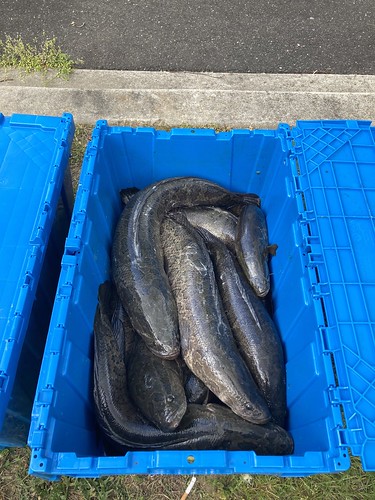
Conowingo Dam stretches across the Susquehanna River between Cecil and Harford counties. Fish lifts built onto the structure help migrating species move upriver, but also catch invasive species. Maryland Department of Natural Resources photo.
Thousands of invasive fish have been removed from the Chesapeake Bay watershed at the Conowingo Dam earlier this year and donated to local food banks through a continuing partnership between Maryland Department of Natural Resources (DNR), Conowingo Dam owner Constellation Energy, environmental consulting firm Normandeau Associates Inc., and local seafood wholesaler J.J. McDonnell and Co. Inc.
The fish lift at Conowingo Dam is essentially a water-filled elevator that collects migrating anadromous fish species, such as American shad, during their spawning run and transports them above the dam into the upper Susquehanna River and their traditional spawning areas. When invasive fish enter the lift, technicians remove them by hand and send them out for beneficial use.
During the 2024 season, which ran from March to June, more than 18,000 pounds of invasive fish were removed from Maryland waters. Species prevented from passing upstream of the dam include 2,106 Chesapeake Channa, also known as northern snakehead; 746 flathead catfish; and 36 blue catfish. The number of Chesapeake Channa removed at the dam was more than double the amount removed in any year since the program began in 2021 (see chart below).

Chesapeake Channa, also known as northern snakehead, retrieved from the Conowingo Dam fish lift. Maryland Department of Natural Resources photo.
To put the harvested fish to good use, J.J. McDonnell processed most for consumption, including a portion they distributed to local food banks in Cecil County. DNR kept some fish for outreach events and scientific research to inform management toward minimizing the impact of these invasive species.
“Invasive fish pose a significant threat to ecologically and economically important native species in Maryland,” said Branson Williams, Maryland DNR’s Invasive Fishes Program Manager. “The removal effort at Conowingo Dam is a prime example of how partnership can amplify our ability to manage invasive fishes and limit their spread.”
Chesapeake Channa and blue and flathead catfish are the most notable and pervasive invasive fish in Maryland. They are all predatory species that consume large amounts of native aquatic species and have few natural predators. The department urges anglers to harvest these species when they catch them and report catches in new areas using the Invasive Species Tracker form on the DNR website.

